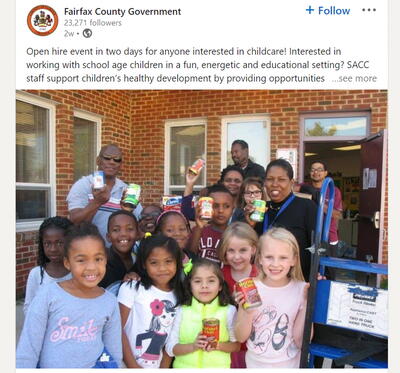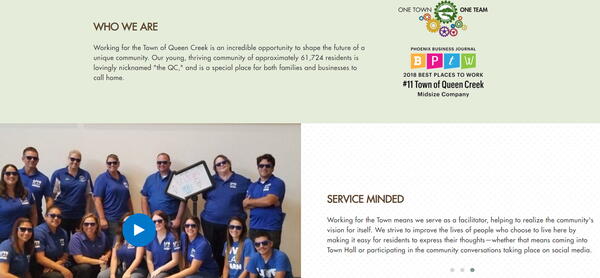
Let me go out on a twig and offer that the number-one issue keeping you awake at night is attracting and retaining great talent. It’s an issue that organizations of every size and in every sector have been grappling with even before the COVID-19 pandemic first disrupted our lives and then the labor market.
Your community isn’t static; it’s highly dynamic, with lots of disruption and change. Yet many of today’s organizational practices and processes for local government agencies were created for comparatively predictable and stable circumstances, with the goal of optimizing long-term efficiency and effectiveness. Recent developments have revealed that many of these practices are ill suited to today’s unpredictable and volatile times. Change and disruption define the “next normal.” Consider the following questions:
- What year is it in your agency? In other words, the dominant mindset of leaders should reflect modern times, but in many instances, it may not. Remember, you can’t fix today’s problems with yesterday’s solutions.
- What are you seeking from your workforce—compliance or commitment?
- Do your employees have a job (i.e., tasks) or a role (i.e., responsibilities)?
- Which is more important—rules or results?
- What’s your approach to hybrid work?
- What gets promoted—seniority or potential?
- Beyond equipping workforce members with technical skills, what’s your agency’s learning and development strategy for leadership-management-supervisory capabilities?
The role of local government is to serve as the protagonist, or advocate, for a better quality of life for residents who volunteer to live in your community. Maintaining a well-prepared, modern workforce is fundamental to ensuring your agency’s continuity of operations. In essence, it’s akin to a risk management strategy because what delivers services is qualified, mission-oriented people motivated to build a stronger community.
Improving (or simply maintaining) workforce productivity is not achieved simply by adding more employees, but instead requires leaders to accept that the work environment has changed, and your approach to talent management must change as well. Talent management has become one of the most pressing topics in organizations and its long overdue for the public sector to transition its mindset from employees to talent. Your organization’s talent is not just employees who are expected to do a job (or for that matter, a role); talent comprises individuals who differ in what they can do and can learn, and what they want to do. To be effective, you need to manage talent in ways that make it a major contributor to your organization’s success.
At the same time, the public sector’s traditional ways of retaining and attracting top-flight talent are not always effective and can be viewed as antiquated. As a result, agencies are increasingly pursuing a more focused approach to strengthening their employer brand, working to entice and retain talent. In fact, the fundamental difference between ordinary and extraordinary organizational performance is the collective ability of its workforce.
Keeping Your Best Performers
If you say that you are mine
I’ll be here ‘til the end of time.
So you got to let me know
Should I stay or should I go?
—The Clash
The place to begin is at home—that is, making sure your existing top performers stay with you. Conventional wisdom says that employees will leave if they are disgruntled, but that giving them enough money will make them stay. That seriously overgeneralizes the matter. People stay in a job or leave it for a range of reasons. A-list employees want to be well compensated, of course, but they are also on the hunt for other kinds of satisfaction, primarily related to learning, growth, and opportunities for making a positive difference.
That’s one reason why high employee turnover isn’t always bad and low turnover isn’t always good. Therefore, it makes sense to start measuring “regrettable” turnover—the number of departing employees the jurisdiction would like to keep. Exit interviews are important, but “retention/stay interviews” are just as useful. Meet with the employees considered to be the organization’s “climbers” or “thoroughbreds,” and ask them one question: “What more can we do as an organization to make you feel satisfied and challenged?” The following factors will probably make up the core of what these top performers are seeking:
Flexibility. Flexibility is the new perk. For many employees, the desire for remote work hasn’t necessarily been driven by the pandemic. Research from Gallup published in 2017 indicated that 37 percent of workers would switch to a job that allows them to work offsite at least part of the time. Now that so many employees have had a taste of that flexibility, that number is likely to grow. According to XpertHR’s Flexible Work Policies and Practices Survey 2021 Report, nearly 90 percent of U.S. organizations are providing flexible work options to increase talent retention. To better manage flexible arrangements, employers are codifying expectations. More than two-thirds are planning to implement policies governing flexible work, and one-third are expecting to implement employee agreements. You do not want to have talented top performers leave your organization due to factors that you can control. It’s time to adopt contemporary policies for flexible work arrangements.
Relationships. Gallup has conducted widespread research on employee engagement, and a significant finding is that people go to work for organizations, but they leave their manager and supervisor. No single issue is more important than the relationship between employees and their supervisors. If employees report that their managers’ expectations are unclear or that their managers provide insufficient equipment, materials, or other resources, watch out.
Characteristics of the Organization. Building a healthy workplace culture—one that is based on an inspirational set of organizational values that employees at all levels aspire to model—is essential for retaining top employees. So are management practices that emphasize shared decision making. Workplace culture is instrumental to enlisting the initiative and participation of top performers. Interested in reading more about the power and influence of the Workplace Culture, please refer to my articles, “A Healthy Workplace Culture is the ‘Secret Sauce’ to Success, Parts 1 and 2.”
Job Design. High performers want and expect to do more than finishing the tasks that comprise their job descriptions. They perceive their work responsibilities not merely as a job, but as a role. When they realize that they don’t have the opportunities to do what they do best, they start to consider their next career stop.
Career Development. Openings for upward mobility are only a portion of the equation for retaining top performers. The investments that organizations make in learning and training, mentoring, and succession planning are also important. Rotating job assignments, “acting” roles, and job shadowing provide attractive opportunities for top performers who want to stretch themselves.
Compensation. Pay and benefits must be competitive, but awarding across-the-board pay raises to employees who do not perform well infuriates the top performers. Pay for performance may sound good in concept, but the application is typically fraught with problems. Distinguishing performance from one employee to another remains a challenge that needs to be overcome in government. But not all rewards are economic. Formal and informal employee recognition efforts should focus on validating top performers for their contributions.
Employer Brand
Your employer brand isn’t a logo, it’s your reputation. —Patrick Ibarra
Across sectors, leaders believe job seekers and candidates are more selective and expect something different from before. One emerging trend is “branding”—in particular, an organization’s employer brand, or the way the employer is perceived both internally and externally as a place to work. Brands are an articulation of culture, vision, history, and the future. Brands are emotional for the people (i.e., employees) who create them, and hopefully they evoke emotions in stakeholders as well.
Every organization has an employer value proposition (EVP), which communicates that image to target audiences and reinforces the reasons why talented people would want to stay with or join the organization. Part of the EVP is the spoken or unspoken exchange between employers and employees that define the relationship. In its simplest form, the exchange represents the money paid for performing a job. In its highest, most strategic incarnation, it’s the promise employers make to provide pay, benefits, career opportunities, and a supportive work environment in exchange for an employee’s discretionary effort to bring the organization’s mission, vision, and values to life.
Branding is a buzzword today, but the business practice behind it isn’t new. Many organizations are adopting what they call brand-building strategies, but often these are merely adopting new logos. This isn’t even close. Essentially, brands influence perceptions in the mind of the public; they are living concepts that change with the organization’s climate and culture. Externally, candidates perceive your employer brand as an indication of the type of employment experience they can expect. Internally, employees perceive your employer brand as how well you deliver on promises and how well they fit within your organizational culture. In short, your employer brand is your identity and reputation as an employer.
Consider your agency’s brand attributes. If you were to choose one that would have the greatest influence on recruiting efforts in today’s competitive markets, what would it be? Do you know the population of candidates who would find that attribute attractive? Do you know how to appeal to them so they will consider working for your organization? Understanding the answers to these and related questions is a dividing line between organizations that are able to hire and keep great talent and those that cannot.
Organizations that invest time, effort, and energy in developing their brand are finding that the advantage of building a reputation for cultivating talent is greater than they may have originally thought. In other words, these organizations are getting a “first-pick advantage.” Consequently, organizations that provide people with opportunities to learn and grow, feature modern life-work balance options, and offer a healthy workplace culture become talent magnets. By continually attracting the most promising candidates and developing them once they’re hired, these organizations become higher-performing and, in turn, continue to attract the best. It’s a self-renewing cycle that expands the capacity of the organization to tackle tougher and more demanding challenges.
The Recruiting Mindset
Hiring is like dating—you get what you look for. —Patrick Ibarra
How can you find the people with the right skills to do the right work at the right time? The power balance between employers and employees has shifted. The fact is there are more jobs than people. The pandemic has prompted employers to rethink traditional ways of operating—and to rethink talent acquisition. As candidates at all levels weigh opportunities differently and the competition for talent continues to intensify, organizations will need to offer an employment experience that candidates prize.
The intent is to bring in new employees who are as good as your current top performers. The marketplace for talent is competitive, so the best recruiting efforts are proactive, dynamic, and capable of engaging candidates. The challenge for public-sector organizations is to manage what comes to mind when prospective candidates think of government as an employer. Job candidates have a certain experience when they research the organization and apply for jobs—good, bad, or indifferent. This experience influences their decisions about whether to apply, accept a job offer, or look somewhere else. What exactly do candidates experience when they interact with your agency as an employer? Do candidates get a sense of what sets the organization apart from other potential employers? What do reviews posted by past job candidates on Glint, Glassdoor, and Indeed offer about your agency?
Many organizations see the recruiting process as a transaction, and the most talented employees do not want to feel like part of a transaction. Instead, employers should try to build a relationship with candidates, starting with the value the organization is offering them. Ultimately, candidates want to understand the value proposition associated with working for this employer. Make sure applicants know:
- What they will gain by working for the agency.
- What the culture is like.
- What the organization’s mission entails.
Many agencies assume their default strategy of “post and pray” will result in a sufficient number of qualified individuals applying for open positions. Agencies also often rely on the misguided notion that the longer a job announcement is posted, the more applicants it will attract.
The following is a series of suggested “next practices” that public-sector leaders should consider as they take a modern approach to recruiting top performers. Always remember that you’re not the audience for your message, so when creating content, it’s about viewing your agency through the eyes of job candidates.
1. Use Social Media.

Social media channels, notably Facebook, LinkedIn, You Tube, Instagram, Snap Chat and Tik Tok, are the most powerful medium for communicating an employer’s brand. Consider using a Facebook add-on application to automatically post any jobs listed on the jurisdiction’s website onto its Facebook page. Join Facebook groups in order to target specific types of people and engage directly with potential applicants. Your agency should use LinkedIn to promote its employer brand and as part of the recruitment strategy, especially when targeting candidates with college degrees.
2. Communicate the Work Culture.
The jurisdiction’s website should offer job seekers a comprehensive view of the organization and its culture in an easy-to-view format. Use images, too—video, if possible—in order to generate a stronger, more emotional response and help candidates who are considering your agency make a stronger connection between their desires and your agency’s purpose. More and more, governments are using videos to tell their story and entice candidates. The city of Tracy, California, has a spectacular police officer recruitment video (https://youtu.be/JEwwe-oiFjw). Some organizations also choose to hire a creative design firm to update their websites, as the skills needed for projecting a first-class image are not in the repertoire of IT technicians.

3. Make Use of Testimonials.
In the same vein, include testimonials from current employees about what they enjoy most about working for your agency on the website, social media channels, and all materials. They relay powerful messages about the job or role and about the work environment. Progress in this area will set your organization apart from other government employers.
4. Make Open Positions Easy to Find.
Your agency should have a job opportunities or careers section on your website’s home page. Each department should list openings, describe the hiring process, provide an FAQ listing, and outline the challenges and satisfaction employees can expect from working in that particular department. This type of message makes a powerful impression on potential candidates. Make sure you’re tracking traffic to your website and evaluate its effectiveness periodically.
5. Make a Good First Impression.
Carefully consider what the organization’s hiring process says about it. As in other aspects of life, first impressions are critical. Bad impressions during the hiring process lead to negative perceptions of the government’s employment brand and can drive away the best talent. Candidates who are accustomed to private-sector hiring practices see a web-based job application process as something of a minimum requirement. Timeliness is another issue. Public-sector employers often require a series of written exams and performance tests as part of their hiring process, but keeping the interest of talented candidates means getting through labor-intensive processes relatively quickly.
6. Reimagine Your Job Announcement.
The world is teeming with smart, skilled, passionate people who are blue-chip prospects—none of whom will be particularly interested in an organization that provides an utterly boring job announcement. Many organizations have had success with more of a social marketing approach that appeals to people of all generations and offers a powerful message: Join this organization and be a part of something truly outstanding as you help make your mark. Look at the town of Queen Creek, Arizona (queencreekaz.gov) and city of Rancho Cucamonga, California (cityofrc.us) for examples.
7. Consider Candidates without Government Experience.
Before recruiting, review the organization’s existing minimum qualifications—specifically, the level of government experience required. Many candidates have extensive experience, strong credentials, and all or most of the desired skills, but no work history in government. Why not look at them? By the way, possessing government experience has no predictive value on a candidate’s ability to succeed in your agency.
8. Stop Relying on Your Human Resources Department to Find High-quality Job Candidates.
It’s not entirely up to HR to find job candidates. Every agency department director is accountable for the performance of their respective department and should be expected to be proactive in strengthening the pipeline of talent considering joining your agency. Department directors should establish and maintain relationships with local high schools, colleges, and universities—from serving as a guest speaker in various classes to asking teachers and professors about students who might be interested in public service. The same goes for relationships with trade schools and labor unions.
Closing
You’re not paid to work; you’re paid to add value. —Patrick Ibarra
There are two sayings that I think sum up this topic: Every organization is perfectly designed to get the results it gets; and if you always do what you’ve always done, you’ll always get what you’ve always got—and that’s not good enough. Not by a long shot. It’s time to do things different and do different things.
Keep an eye out for “Help Wanted, Part 2” in the August issue, where I focus on how the rapidly changing role of the human resources department is related to your agency’s ability to attract and retain talent.

PATRICK IBARRA and his consulting firm, the Mejorando Group, are passionate about unleashing human potential (patrick@gettingbetterallthetime.com).
New, Reduced Membership Dues
A new, reduced dues rate is available for CAOs/ACAOs, along with additional discounts for those in smaller communities, has been implemented. Learn more and be sure to join or renew today!
